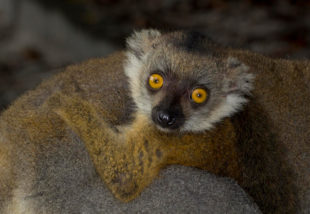Not half a meter tall, having with two kilos the weight of a small cat and pitch-black colored: These are black lemurs (Eulemur macaco). However, only the males are black. The females have little to do with the name. Their coat is reddish-brown, only their face and hands are black, the first one framed by a white coat wreath.
Black lemurs originally live in the river delta along the Sambirano in the northwest of Madagascar. Some surrounding islands such as Nosy Be, Nosy Tanikely, and Nosy Faly are also home to small populations.

Black lemurs have also been settled by humans on the islands of Nosy Komba on the northwest coast and in the Akanin’ny Nofy reserve on the east coast. Their actual habitat is the rainforest, but they can also cope with orchards and secondary vegetation. On the IUCN’s red list, black lemurs are now listed as “endangered”, as their habitat is increasingly dwindling and highly fragmented due to slash-and-burn. If black lemurs plunder fruits in plantations, they are frequently killed and less often hunted for consumption. Unfortunately, the species is also frequently used as a pet lemur because of its curiosity and trustfulness. Young animals are caught illegally and then kept in small cages, partly as illegal pets, partly as forbidden photo motifs for tourists. The isolated keeping of the social lemurs and wrong diet usually causes early death in Madagascar in human hands – but black lemurs can live 15 to 20 years in the wild. The oldest known black lemur was even 38 years old, he lived in a zoo in Illinois (USA).
In nature, these small journeymen are cathemeral, which means that they are neither strictly night nor day-active like other mammals. Depending on the season, climate, and food supply, they are sometimes more active in the early morning, sometimes more active in the evening. In very bright nights, around a full moon, they are much more active at night – no wonder, they don’t see very well at night and need at least a little light to find food.

A group of black lemurs consists of five to fifteen animals. The lemurs do not have to be closely related to each other. Usually, two or three pairs come together as a group, which then raises the offspring together. A female is the boss of the troop. However, black lemurs are generally not particularly argumentative. Their precincts can become as big as eight football fields, but they often overlap with those of other groups. Also opposite other species black lemurs act rather restrained. Their spread-area borders partially on those of the red-bellied lemurs and the brown lemurs, in the same precinct, above all sportive and mouse lemurs occur otherwise.
The end of the rainy season heralds the mating season of the black lemurs. Although there are fixed relationship partners, this does not mean that reproduction only takes place with these. Most females change their sexual partners several times – even males of foreign groups can be among them. Approximately four months after mating, the female gives birth to one young, now and then twins. It is then the end of the dry season. During the first weeks, the young lives well hidden on their mother’s belly, with the onset of the rainy season and a better supply of food it climbs on her back and makes its first excursions in the trees. Already at the age of half a year, the young black lemurs are weaned, because the mother prepares for the next sibling. At the age of only two years, the young black lemurs are sexually mature.

The diet of the small lemurs consists mainly of fruits such as coffee, mango, and papaya, which grow particularly well in the rainy season from November to April. They also eat flowers, nectar, and leaves. Black lemurs became famous with a film from BBC Earth, which showed the small monkeys eating millipedes. They press and nibble on the colorful insects until they release a poisonous defense secretion. Then the lemurs rub the millipedes all over their bodies. Scientists suspect that black lemurs use the weir secretion as protection against mosquitoes and ticks. However, it is also undisputed that the small lemurs get a little high from licking the millipedes. It remains unclear whether black lemurs deliberately induce drug intoxication or whether it is just a nice side effect. Most millipedes survive the procedure by the way – so that the black lemurs can reuse them for the next drug session soon.
 MADAMAGAZINE Your Magazine about Madagascar
MADAMAGAZINE Your Magazine about Madagascar










